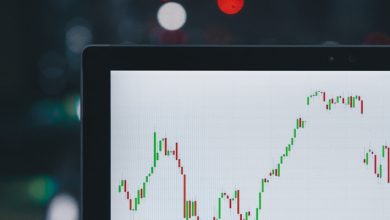Crypto Volatility Explained: Causes and Strategies to Navigate It

- Understanding the factors that contribute to cryptocurrency volatility
- The role of market sentiment in driving crypto price fluctuations
- How regulatory developments impact the stability of digital assets
- Strategies for risk management in a volatile crypto market
- The influence of market manipulation on cryptocurrency prices
- Tools and resources to help investors navigate crypto market volatility
Understanding the factors that contribute to cryptocurrency volatility
There are several factors that contribute to the volatility of cryptocurrencies. One of the main reasons is the lack of regulation in the market. Without proper oversight, prices can fluctuate wildly based on speculation and market manipulation.
Another factor is the relatively small market size of cryptocurrencies compared to traditional assets. This means that even small trades can have a significant impact on prices, leading to sharp movements in either direction.
Additionally, the news cycle plays a big role in the volatility of cryptocurrencies. Positive news, such as a major company adopting a cryptocurrency, can cause prices to surge, while negative news, such as a hack or regulatory crackdown, can lead to sharp declines.
Overall, it’s important for investors to understand these factors and have a solid strategy in place to navigate the volatility of the cryptocurrency market. Diversification, risk management, and staying informed are key components of a successful approach to investing in cryptocurrencies.
The role of market sentiment in driving crypto price fluctuations
Market sentiment plays a crucial role in driving fluctuations in the prices of cryptocurrencies. The perception of investors and traders about the market conditions, news, and events can heavily influence their buying and selling decisions, leading to rapid price changes in the crypto market.
Investors’ emotions, such as fear, greed, optimism, and pessimism, can create a herd mentality that drives prices up or down. Positive news, like regulatory approvals or partnerships, can create a sense of optimism among investors, leading to a buying frenzy and a subsequent price increase. Conversely, negative news, such as exchange hacks or regulatory crackdowns, can spark fear and panic selling, causing prices to plummet.
Understanding market sentiment is essential for navigating crypto volatility successfully. By staying informed about market developments, monitoring social media channels, and analyzing trading volumes, investors can gain valuable insights into market sentiment trends. This information can help them make informed decisions about when to buy or sell cryptocurrencies to capitalize on price fluctuations.
In conclusion, market sentiment is a powerful force that drives crypto price fluctuations. By paying attention to market sentiment indicators and staying informed about market developments, investors can better navigate the volatile crypto market and make strategic investment decisions.
How regulatory developments impact the stability of digital assets
Regulatory developments play a crucial role in shaping the stability of digital assets in the crypto market. Government regulations can have a significant impact on the value and volatility of cryptocurrencies. When regulators announce new policies or restrictions, it can cause uncertainty and fear among investors, leading to sharp price fluctuations.
One way in which regulatory developments influence digital asset stability is through compliance requirements. Cryptocurrency exchanges and other platforms may need to adhere to new regulations, which can increase operational costs and create barriers to entry for some market participants. This can result in decreased liquidity and heightened price volatility as a consequence.
Moreover, regulatory crackdowns on certain cryptocurrencies or initial coin offerings (ICOs) can lead to a loss of trust in the overall market. Investors may become wary of investing in digital assets if they fear that their holdings could be targeted by regulators. This lack of confidence can exacerbate price swings and contribute to overall market instability.
On the other hand, clear and favorable regulations can have a positive impact on the stability of digital assets. When regulators provide guidance that supports innovation and protects investors, it can help legitimize the market and attract more institutional capital. This can lead to increased stability and reduced volatility in the long run.
Overall, regulatory developments are a key factor to consider when analyzing the stability of digital assets. Investors should stay informed about the latest regulatory updates and be prepared to adapt their strategies in response to changing market conditions. By understanding how regulations can impact the crypto market, investors can better navigate volatility and make informed decisions about their investments.
Strategies for risk management in a volatile crypto market
When navigating the volatile crypto market, it is crucial to have a solid risk management strategy in place to protect your investments. Here are some effective strategies to help you mitigate risks:
- Diversification: Spread your investments across different cryptocurrencies to reduce the impact of volatility on your portfolio.
- Stop-loss orders: Set up stop-loss orders to automatically sell your assets if they reach a certain price, limiting your losses.
- Stablecoins: Consider investing in stablecoins, which are pegged to a stable asset like the US dollar, to hedge against market fluctuations.
- Stay informed: Keep yourself updated on market trends, news, and developments to make informed decisions and react quickly to changes.
- Use technical analysis: Utilize technical analysis tools to identify trends and patterns that can help you predict market movements.
By implementing these risk management strategies, you can navigate the volatile crypto market with more confidence and minimize potential losses. Remember that volatility is a natural part of the crypto market, and being prepared is key to successful investing.
The influence of market manipulation on cryptocurrency prices
Cryptocurrency prices can be heavily influenced by market manipulation. Market manipulation refers to actions taken by traders or investors to artificially inflate or deflate the price of a cryptocurrency. This can be done through various tactics such as pump and dump schemes, spoofing, and wash trading. These manipulative practices can create a false sense of demand or supply, leading to sharp price movements that may not reflect the true value of the cryptocurrency.
One common form of market manipulation is pump and dump schemes. In a pump and dump scheme, a group of traders work together to artificially inflate the price of a cryptocurrency by spreading positive rumors or false information. Once the price has been pumped up to a certain level, the group will then sell off their holdings at a profit, causing the price to crash. This can result in significant losses for unsuspecting investors who bought in at the inflated price.
Spoofing is another form of market manipulation where traders place large buy or sell orders with no intention of executing them. These fake orders create the illusion of demand or supply, tricking other traders into making decisions based on false information. Once the market moves in the desired direction, the spoofers cancel their orders and take advantage of the price movement.
Wash trading involves a trader buying and selling the same cryptocurrency to themselves to create fake trading volume. This can give the impression of high liquidity and activity in the market, attracting more investors. However, this artificial inflation of trading volume can distort price information and make it difficult for traders to accurately assess the true market conditions.
Overall, market manipulation can have a significant impact on cryptocurrency prices, leading to increased volatility and potential losses for investors. It is important for traders to be aware of these manipulative practices and to use caution when making investment decisions in the crypto market.
Tools and resources to help investors navigate crypto market volatility
Investors looking to navigate the volatile crypto market can take advantage of various tools and resources to make informed decisions. By utilizing these resources, investors can better understand market trends and develop strategies to manage risk effectively. Here are some key tools and resources to help investors navigate crypto market volatility:
1. **Cryptocurrency Exchanges**: Utilize reputable cryptocurrency exchanges to buy, sell, and trade digital assets. These platforms offer advanced charting tools, real-time market data, and order types to help investors make informed decisions.
2. **Technical Analysis Tools**: Use technical analysis tools such as moving averages, Relative Strength Index (RSI), and Bollinger Bands to analyze price movements and identify potential entry and exit points. These tools can help investors predict market trends and adjust their strategies accordingly.
3. **Educational Resources**: Take advantage of educational resources such as online courses, webinars, and articles to enhance your knowledge of cryptocurrency markets. Understanding fundamental concepts and market dynamics can help investors make better-informed decisions during periods of volatility.
4. **Risk Management Strategies**: Implement risk management strategies such as setting stop-loss orders, diversifying your portfolio, and only investing what you can afford to lose. These strategies can help mitigate potential losses during volatile market conditions.
5. **Social Media and News Outlets**: Stay informed about the latest news and developments in the cryptocurrency space by following reputable social media accounts and news outlets. Keeping up-to-date with market news can help investors anticipate potential market movements and adjust their strategies accordingly.
By utilizing these tools and resources, investors can better navigate the unpredictable nature of the crypto market and make informed decisions to achieve their investment goals. Remember to conduct thorough research and seek advice from financial professionals before making any investment decisions.



